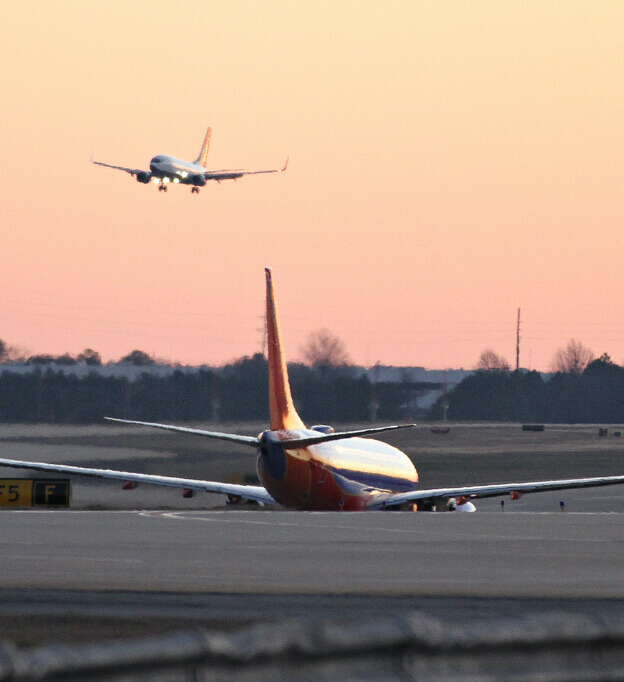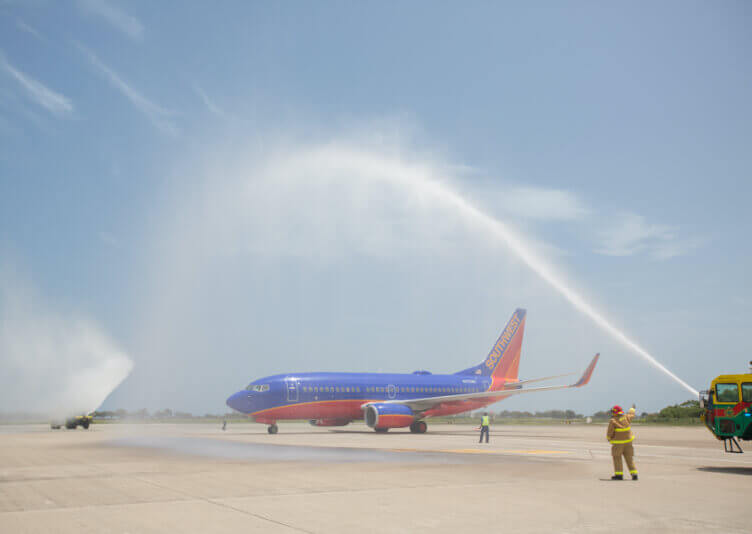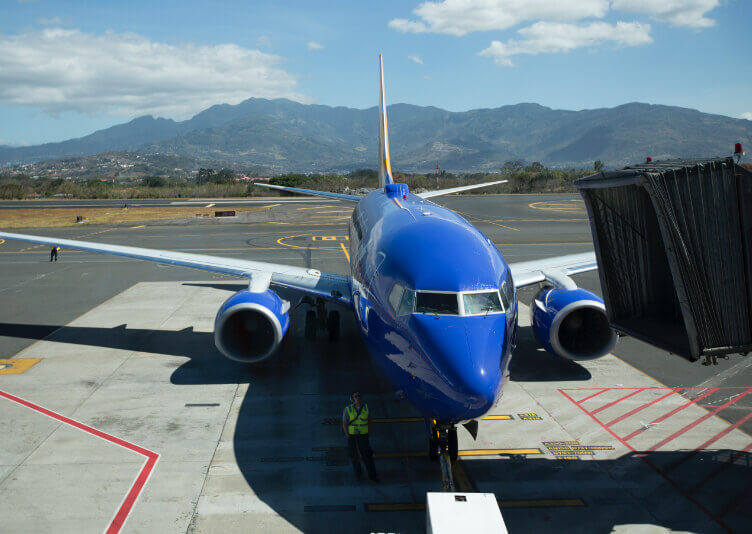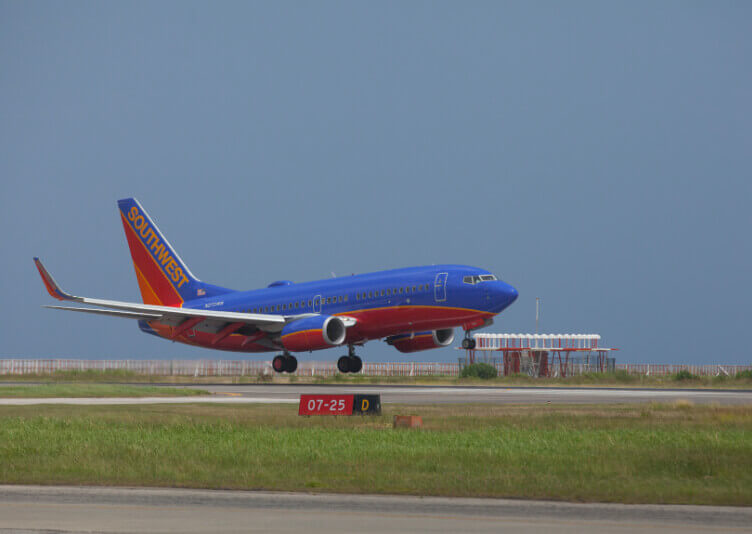
One of the first Southwest flights departing Atlanta. The acquisition of AirTran paved the way toward international service.
Island Paradise: Launch of International
We’re surrounded by too much white space. That was the general consensus as Southwest surveyed its route map in the wake of the Great Recession in the late 2000s.
Domestically, there were pins in all the right places. Minus a few lingering needs, Southwest possessed enviable strength from sea to shining sea.
The contiguous U.S. wasn’t the issue. It was all those dazzling destinations encircling it—zero pins in zero international destinations—that seemed unwise to ignore any longer.
Give us more sun and more Southwest fun. That’s what Customer survey after Customer survey said. Give us new places to explore, especially Latin American beach destinations and vacation hubs, where most fares remained stubbornly overpriced.
“All across the network, Customers were asking us to take them just a little bit farther than we were today, to help them go on vacation or go see family,” recalls Chief Commercial Officer Andrew Watterson.
Transforming Southwest into an international air carrier, however, would be a Herculean task requiring coordinated efforts from every single Southwest Department. The Company’s checklist included: Selecting and mapping out flight paths to new international destinations and obtaining the required certifications. Updating the reservation system. Training new international Employees. Tackling issues related to customs and immigration. And those were just the first few bullet points on the list.
Fortunately, Southwest Leadership devised a critical shortcut. Having successfully weathered the 2008-2009 financial crisis better than most of its rivals, Southwest found itself in a strong enough financial position to make an acquisition. Which is precisely what Southwest did on September 27, 2010, when it announced a definitive agreement to acquire AirTran Airways.
The domestic benefits of the deal were readily apparent. It would provide Southwest a vital foothold at Atlanta’s Hartsfield-Jackson International Airport, while strengthening its presence in other key domestic markets. The real clincher, however, proved to be the routes AirTran had already established in Mexico and the Caribbean, as well as its experience handling international logistics and flight operations.
By leaning on this foundational experience, Southwest felt it could make the pivot toward international markets not only quicker but in ways that defied convention.

Southwest’s first flight to Jamaica arrives on July 1, 2014.
Case in point: When airlines contract with vendors to hire new international employees, they might fail to fully integrate these new recruits into the company, eroding away any loyalty or kinship they might feel for their employer. Southwest, by contrast, made it a priority to fully welcome international contractors into the Family by flying them to Dallas for specialized training and bonding experiences with their peers. This not only would encourage these companies to provide Southwest’s international Customers the same Fun-LUVing Attitude that Southwest provides in the United States, but it showed these newcomers that Southwest cares about them as well. “And then,” says Andrew, “they went back and they represented us with gusto in their home countries.”
Then there were the tangled knots that come with updating an airline reservation system, one of the main drivers of confusion, ticket errors, and dissatisfaction when carriers go international. It’s “almost like a heart transplant surgery,” says Andrew. “You need to then replace the entire reservation system in order to have a modern one that allows for international travel.”
In most cases, airlines make an abrupt shift, completely migrating from one system to another. Southwest devised a smoother approach. It decided to operate three different systems concurrently—the former AirTran system, its domestic-based legacy system, and a new international system—while slowly transitioning all flights into its new system over time.
Collectively, these changes required unprecedented coordination and Teamwork. As former Senior Vice President Customers Teresa Laraba later told reporters: “There hasn’t been a department that hasn’t been touched by this.” But there was a sense of exhilaration and adventure as well, the adrenaline rush of adding new locations where no Southwest plane had gone before.

Southwest’s inaugural flight touches down in beautiful Costa Rica.
It felt, in some ways, like the early years of the Company when Southwest swept westward from Texas, then doubled back across the Midwest and toward the East Coast. Founder Herb Kelleher was fond of telling his early Employees, “Never rest on your laurels or you’ll get a thorn in your ass.”
Now a new generation was picking up that baton of freedom and flying farther with it, fueled by Chairman and CEO Gary Kelly’s admonition to “Remember that success is never final.” Gary did what Southwest Leaders always do when presented with a worthwhile expansion opportunity. He ordered another box of thumbtacks and began sticking them on the map.
Although AirTran had already initiated service to Cancun in 2009, its list of international destinations was expanded in 2012 to include Mexico City and Cabo San Lucas/Los Cabos. Critical capital investments were made, including the construction of a new five-gate international facility at Houston’s Hobby Airport, which opened in October 2015. Reservations updates progressed as well during the final legs of the project.
By January 2014, Southwest was ready to circle an official date on its calendar—July 1, 2014—to make its international debut. On that day, Southwest sent its planes for the first time beyond the borders of the United States to Aruba; Nassau in the Bahamas; and Montego Bay, Jamaica; from Atlanta, Baltimore/Washington, and Orlando.

Flight #906 to Jamaica touches down into a vacation!
When the big day arrived, cakes were rolled out at airports and Southwest facilities. The pride was palpable. Teresa, who was on the inaugural Southwest flight from Baltimore/Washington to Aruba, was not alone when she told the press, “It’s probably going to be the most momentous day for me as a Southwest Employee.”
As to be expected, there was a rush of media attention, but what was remarkable in the weeks to follow was the lack of heated complaints or serious reservation errors. The relative silence spoke volumes about the success of the transition.
On the other hand, the substantial changes worth noting were uniformly positive. As additional Southwest destinations were added—includingHavana, Cuba and Cozumel, Mexico—more Customers signed up to become Rapid Rewards® Members. Plus, every international destination Southwest added to its flight map produced lower average fares and boosted the number of people who flew to that location—proving the Southwest Effect was alive and well, even beyond the borders of the United States.
The success of Southwest’s expansion efforts to international beach destinations built tremendous momentum to add Hawaii to its route map in 2019 as well—leaving plenty more white space to fill in during the years to come.
“I think that was one of the all-time highlights in my 34 years, just to see what our People could do,” said Gary, looking back at the expansion years later. “A very, very exciting time—[and] very key to the success that we’ve seen since then.”
